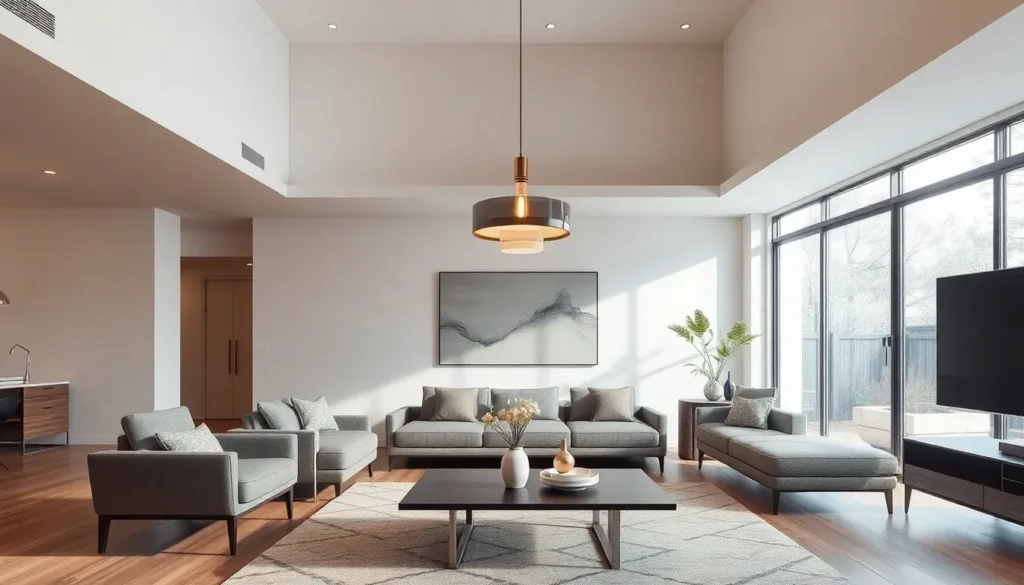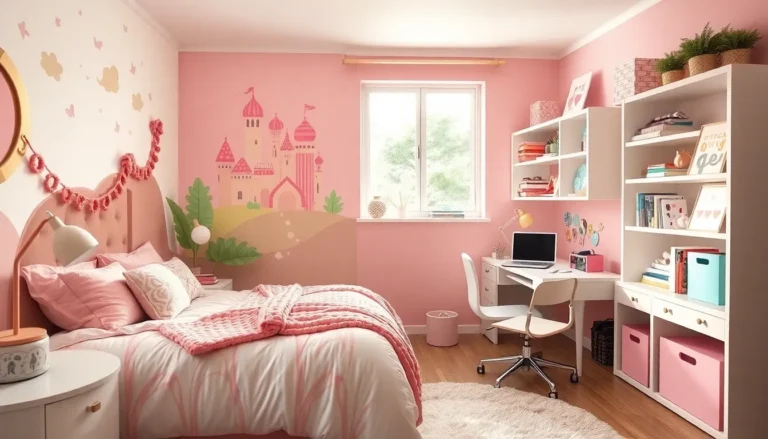Lighting fixtures play a crucial role in shaping the ambiance of any space. From cozy living rooms to bustling offices, the right lighting can enhance functionality while adding a touch of style. With an array of designs, materials, and technologies available, choosing the perfect fixture can transform a mundane room into a vibrant haven.
As homeowners and designers seek innovative ways to illuminate spaces, understanding the different types of lighting fixtures becomes essential. Whether it’s the sleek lines of modern pendant lights or the warm glow of vintage chandeliers, each option offers unique benefits. This article delves into the world of lighting fixtures, exploring their impact on aesthetics and practicality, and guiding readers toward making informed choices that brighten their environments.
Table of Contents
ToggleOverview of Lighting Fixtures
Lighting fixtures serve as essential components in establishing the atmosphere of any space. Different types of fixtures provide varied lighting effects, contributing to both aesthetics and functionality. Understanding the various categories helps homeowners and designers select options that align with their design vision.
Types of Lighting Fixtures
- Ceiling Lights: Ceiling lights include flush mounts and chandeliers, designed to illuminate entire rooms. These fixtures save space while providing essential overhead light.
- Wall Sconces: Wall sconces attach to walls and direct light upwards or downwards. These fixtures enhance ambiance and can serve as decorative elements in hallways or living areas.
- Table Lamps: Table lamps offer versatility and portability. They work well for task lighting, making them suitable for reading nooks and desks.
- Floor Lamps: Floor lamps emphasize height and can create interest in various room corners. They provide focused light or surrounding illumination.
- Pendant Lights: Pendant lights hang from ceilings and work effectively over dining tables or kitchen islands. They offer both style and functionality.
Key Considerations
Select lighting fixtures based on specific needs and design requirements. Consider factors such as the intended use of the space, the desired atmosphere, and the existing decor. Proper placement and combination of multiple fixtures enhance overall illumination and style.
Popular Materials
Choose materials based on durability and aesthetic preference. Common materials include:
- Metal: Metal fixtures, such as brass and chrome, provide a contemporary touch.
- Glass: Glass fixtures diffuse light beautifully, adding elegance to any setting.
- Fabric: Fabric shades soften light, creating a warm and inviting atmosphere.
Maintenance Tips
To ensure longevity, regular maintenance is necessary. Clean fixtures to avoid dust accumulation and check for bulb functionality periodically. This practice maintains optimal lighting conditions and extends the fixture’s life.
Understanding these components empowers individuals to make informed decisions about lighting fixtures, enhancing both form and function in their environments.
Types of Lighting Fixtures

Various types of lighting fixtures serve distinct purposes in enhancing the atmosphere of spaces. Understanding these categories helps in making informed decisions for optimal lighting design.
Ambient Lighting Fixtures
Ambient lighting fixtures provide general illumination for spaces, creating a uniform light distribution. Examples include:
- Ceiling Lights: These fixtures, installed directly onto the ceiling, offer broad lighting coverage. Options range from flush mounts to recessed lights.
- Chandeliers: Ideal for entryways or dining areas, chandeliers deliver elegance while illuminating larger spaces.
- Floor Lamps: Positioned in corners or next to furniture, floor lamps enhance brightness and can serve as decorative elements.
Task Lighting Fixtures
Task lighting fixtures focus on specific areas to aid in various activities. They help increase visibility in workspaces. Key examples include:
- Table Lamps: Commonly used on desks or bedside tables, table lamps provide concentrated light for reading or working.
- Under-Cabinet Lights: Installed beneath kitchen cabinets, these fixtures illuminate countertops, making food preparation easier.
- Wall Sconces: Mounted on walls, sconces offer directed light for tasks such as reading in living rooms or illuminating artwork.
Accent Lighting Fixtures
- Spotlights: Used to highlight architectural details or artworks, spotlights create focal points in any room.
- Track Lighting: Adjustable and versatile, track lighting permits users to direct light wherever needed, making it suitable for galleries and retail spaces.
- LED Strip Lights: These flexible lights can be applied along shelves or within coves, adding subtle highlights to interior designs.
Factors to Consider When Choosing Lighting Fixtures
Selecting the right lighting fixtures requires careful consideration of several factors. Understanding each element helps in achieving both functional and aesthetic goals.
Size and Scale
Choosing the appropriate size and scale ensures the fixture complements the space. Determine room dimensions by measuring the length and width, then calculate the ideal fixture size. A common guideline for pendant lights suggests that fixture diameter should be about one-half the width of the table it hangs above. For larger rooms, opt for fixtures with more substantial designs to fill the vertical space effectively. Maintaining scale within the room creates a balanced and cohesive look.
Style and Aesthetics
Selecting the style and aesthetics of lighting fixtures affects the overall decor of a room. Consider existing furniture, color schemes, and architectural features before making selections. Fixtures should either complement or contrast with the decor, enhancing the desired ambiance. Popular styles include contemporary, industrial, farmhouse, and traditional. Examining material options such as metal, glass, or fabric helps in finding a style that aligns with personal taste and space requirements.
Energy Efficiency
Prioritizing energy efficiency promotes sustainability and reduces electricity costs. When choosing lighting fixtures, opt for LED bulbs, which consume up to 75% less energy compared to incandescent bulbs. Check the lumens output to ensure adequate brightness while maintaining energy savings. Look for ENERGY STAR-rated fixtures, indicating high efficiency and quality. By selecting energy-efficient options, homeowners benefit from lower utility bills while contributing to environmental conservation.
Installation and Maintenance Tips
Proper installation and regular maintenance of lighting fixtures ensure safety, efficiency, and longevity. Following specific guidelines and best practices leads to optimal performance.
Installation Guidelines
- Turn Off Power: Always switch off power at the circuit breaker before starting any installation to prevent electrical shocks.
- Read Instructions: Consult the manufacturer’s installation instructions to understand specific requirements for each fixture.
- Placement: Position fixtures based on room function. Install ambient lighting centrally, task lighting over work areas, and accent lighting to highlight features.
- Secure Mounting: Use appropriate anchors and screws to securely mount ceiling and wall fixtures, ensuring they can support the weight.
- Wire Connections: Connect wires using wire nuts. Match colors – black to black, white to white, and green or bare to ground.
- Test the Fixture: After connecting wires, restore power and test the fixture to ensure proper operation before finalizing installation.
Maintenance Best Practices
- Dust Regularly: Clean fixtures with a microfiber cloth to remove dust and prevent buildup that can affect light output.
- Check for Damage: Inspect wires and fixtures for wear or damage periodically. Replace any frayed wires or broken components immediately.
- Change Bulbs Promptly: Replace burnt-out bulbs promptly to maintain optimal brightness and prevent strain on the fixture.
- Use Correct Bulbs: Utilize recommended bulbs (wattage and type) to prevent overheating and ensure compatibility with the fixture’s specifications.
- Professional Help: For complex installations or repairs, consult a licensed electrician to ensure safety and compliance with local codes.
Choosing the right lighting fixtures can significantly impact any space’s ambiance and functionality. By understanding the various types available and their specific uses, individuals can create an environment that reflects their style and meets practical needs.
It’s essential to consider factors like size, scale, and energy efficiency when selecting fixtures. Proper installation and regular maintenance ensure these investments not only enhance the aesthetic appeal but also provide long-lasting performance.
With thoughtful choices, lighting can transform ordinary rooms into inviting and vibrant areas, making it a crucial element in interior design.



